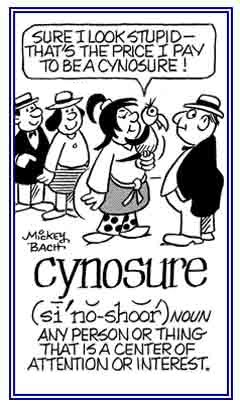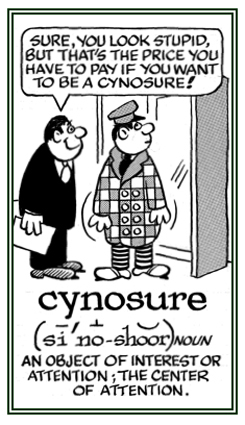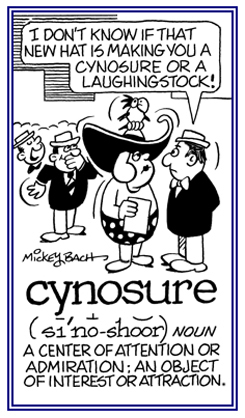uro-, ur-, -urous, -ura, -uroid, -urus, -uridae
(Greek: tail, tail-like)
Don't confuse this uro- unit with another uro- unit which refers to "water, rain, and urine".
anthurium
anurous
brachyurous
1. The center of admiration, attention, or attraction: The famed pianist was the cynosure of the critics for the newspapers.
2. An object that serves as a focal point of attention and admiration: The iceberg was the cynosure for the tourist boat in the Arctic.
3. Someone or something acting as a guide or used for direction: The cynosure at the intersection of the two roads helped to reassure Mark that he was going in the right direction to the museum.
4. Etymology: from about 1596, from Middle French (c.1400-c.1600) cynosure, from Latin Cynosura; literally, "dog's tail; the constellation (now Ursa Minor) containing the North Star (which contains the guiding star Polaris), the focus of navigation; from Greek kynosoura, literally, "dog's tail".

© ALL rights are reserved.

© ALL rights are reserved.

© ALL rights are reserved.
Go to this Word A Day Revisited Index
2. An object that serves as a focal point of attention and admiration: The iceberg was the cynosure for the tourist boat in the Arctic.
3. Someone or something acting as a guide or used for direction: The cynosure at the intersection of the two roads helped to reassure Mark that he was going in the right direction to the museum.
4. Etymology: from about 1596, from Middle French (c.1400-c.1600) cynosure, from Latin Cynosura; literally, "dog's tail; the constellation (now Ursa Minor) containing the North Star (which contains the guiding star Polaris), the focus of navigation; from Greek kynosoura, literally, "dog's tail".



Go to this Word A Day Revisited Index
for a list of additional Mickey Bach illustrations.
urochord
1. A flexible skeletal rod notochord that supports the posterior part of the body in some sea animals such as sea squirts.
2. The notochord (flexible rodlike structure) of an ascidian (marine animal with a saclike body and siphons through which water enters and leaves) or tunicate (marine animal with a saclike body), more conspicuous in the larva than in the adult and confined primarily to the caudal (tail or hind) region of the body.
2. The notochord (flexible rodlike structure) of an ascidian (marine animal with a saclike body and siphons through which water enters and leaves) or tunicate (marine animal with a saclike body), more conspicuous in the larva than in the adult and confined primarily to the caudal (tail or hind) region of the body.
urodele
uropod
Uropsilus soricipes
A shrew mole of eastern Asia.
Uropygi
Whip scorpian.
The name uropygid means "tail rump", referring to the whip-like flagellum on the end of the pygidium, a small plate made up of the last three segments of the abdominal exoskeleton.
Whip scorpions have glands near the rear of their abdomen that can spray a combination of formic and acetic acid when they are bothered.
The acetic acid gives this spray a vinegar-like smell, resulting in the common name vinegaroon.
uropygial
In ornithology, situated on, belonging to, the rump or uropygium.
uropygium
In ornithology, the rump of birds.
<img src="/img/left_arrow_sm.gif" alt="" /> <img src="/img/right_arrow_sm.gif" alt="" />
Showing 1 page of 11 main-word entries or main-word-entry groups.
